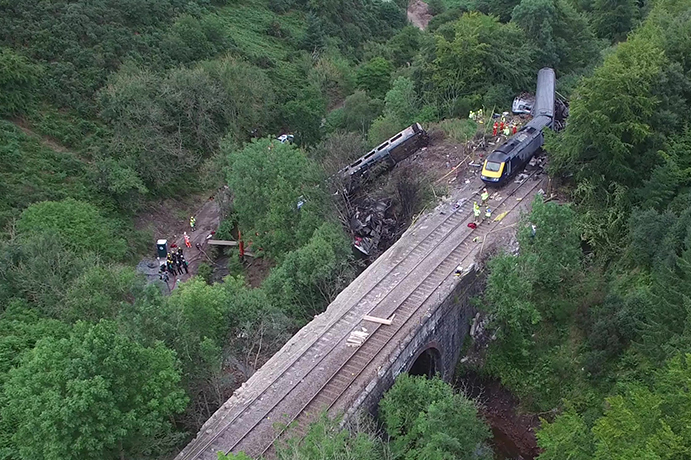We are entering a period of climatic uncertainty and disruption that will have a profound effect on how we live and travel. Transport already accounts for a nearly ¼ of global energy-related C02 emissions; we know we need to reduce emissions and build resilience.
Network Rail’s own climate projections point to increasing average and maximum daily temperatures, drier summers, wetter winters, sea level rises and increased storminess – all of which pose wide ranging and difficult questions to rail operators. Already we are experiencing the effects of climate change.
In August 2020 tragedy struck on our railway. A train derailed near Carmont, Aberdeenshire resulting in loss of life and considerable suffering. Analysis found that heavy rainfall had caused gravel and other material from nearby land to wash onto the tracks causing the train derailment. It was a disaster in which climate change played a damning role.
Network Rail’s Chief Executive said after the tragedy that extreme weather now presented a “constant challenge to the safety and reliability of the railway”. Reports were commissioned and improvements introduced to help mitigate the impact of extreme weather, and improve the resilience and safe performance of the rail network. And that work continues.

The challenge ahead
Public transport will play an essential role in addressing the climate emergency in the coming decades and Network Rail are investing in new ways to manage the railway more efficiently and safely, while also increasing capacity. With 1.7 billion rail journeys a year, and the climate crisis likely to worsen in the years ahead unless carbon reduction targets are met, the need to future-proof our railways is essential to reduce disruptions and associated costs.
Over the past 15 years, weather related events have resulted in more than £3bn in delays. A 2015 report found that 580 stations and 2,400 km of track were at a high risk of flooding, which is likely to be the network’s biggest problem. Higher temperatures and stronger winds will also cause more faults and damage as lines buckle and infrastructure is damaged, and extreme thunderstorms and sea surges all add to a chaotic climatic future. Combine this with a near 200-year old rail network and the challenge is real and significant.
Adaptation plans
Network Rail are responding, and we are starting to play a crucial role as part of that effort. Weather Resilience and Climate Change Adaptation (WRCCA) plans are routinely used to manage these risks. Also. a few months ago they released their third Adaptation Report to “better understand the risks and impact [climate change] will have on our infrastructure”. Plans are in place to respond and adapt to risks over the short, medium and long term.
Recently our teams at Ecus have been supporting this work. We undertook a weather and climate change resilience assessment for a client to understand how future changes would impact line upgrades, and to identify mitigation in order for these upgrades to be resilient in the decades ahead.
As part of our work, we researched and analysed a range of technical, construction and operational factors, using climate change projections and historic weather data to determine potential impacts and likely failure rates on the assets and line. We proposed a range of recommendations for further consideration so that the line could be as safe and robust as possible.
Our report concluded (amongst other things) that flooding, high winds and changes in temperature will have a negative effect on operations – no surprise there. However, we also identified adaptation and mitigation options.
Take one ecological example; higher temperatures and more precipitation will affect growth and success rates of different vegetation. As older trees (and those unsuited to a warming climate) die, then the chance of falling hazards increases, not least as stronger winds and storms become more frequent. What’s more, warmer temperatures are likely to result in trackside vegetation growing at a faster rate, again presenting safety risks. There will be a need for more regular monitoring and removal of trackside vegetation, whilst also being mindful of wider biodiversity protection and enhancement goals.

Light at the end of the tunnel
We live in an age of uncertainty, but we know that transformative change is needed. Here at Ecus we are proud to be playing our part in helping clients to identify and mitigate risks, both now and in the future. From water management, arboriculture, ecology services, and environmental assessment and planning, through to climate and weather resilience, low carbon solutions and air quality services, we are supporting a diverse range of clients to build resilience. Whether you go by path, road or rail, we are there to help make your journey more resilient and sustainable.




